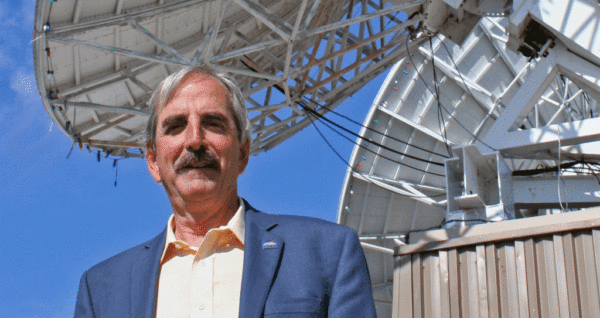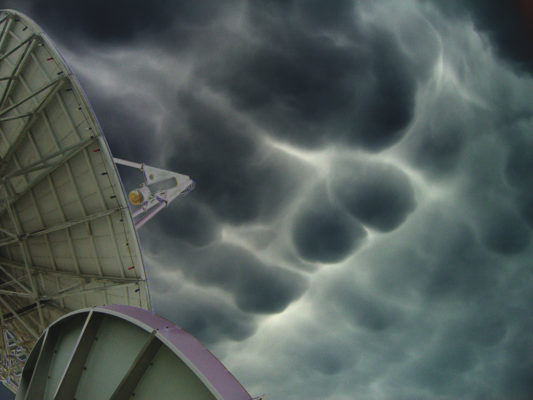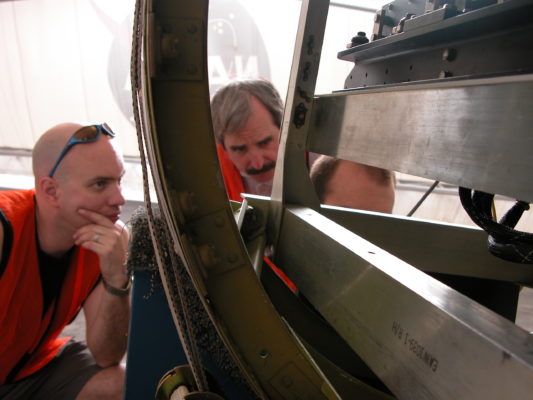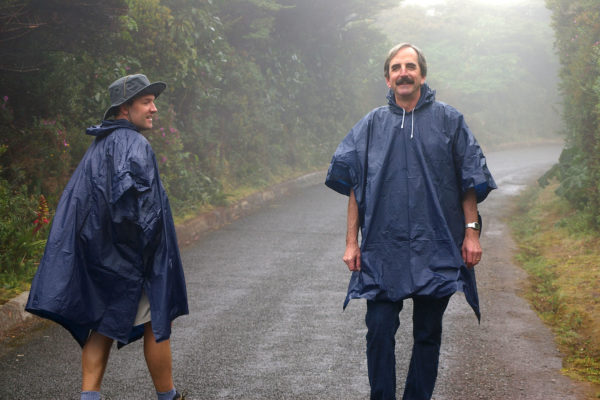Hank Revercomb: Fellow of the American Meteorological Society
Pioneering, precision, and accuracy are the watchwords of Hank Revercomb’s career and contributions to the United States meteorological satellite program. His peers, and the American Meteorological Society, agree.
Revercomb, senior scientist and former director at the University of Wisconsin-Madison (UW-Madison) Space Science and Engineering Center (SSEC), was nominated by his peers and elected a 2017 Fellow of the American Meteorological Society for his achievements and contributions to the atmospheric sciences. His leadership on an intricate lineage of satellite-, aircraft-, and ground-based instruments has left an unmistakable imprint on the quality of atmospheric observations that have proven critical to better weather forecasts.

Hank Revercomb on the roof of the Space Science and Engineering Center, University of Wisconsin-Madison. Credit: Bill Bellon.
William L. Smith, UW-Madison professor emeritus and colleague of nearly forty years, led the nomination. “It did not take me long to realize that Dr. Revercomb was a most gifted physicist,” wrote Smith. “His scientific and engineering excellence in the measurement of environmental variables for operational weather prediction and research have led to today’s operational satellite sounding instruments.”
Revercomb’s curiosity about methods to characterize the thermodynamics of gaseous systems extends back to his 1972 dissertation on the Boltzmann equation. This equation describes transport properties, such as thermal conductivity, when a fluid is not in equilibrium, as in the atmosphere.
This expertise made him a natural fit for the research teams at SSEC, then under the leadership of SSEC founder Verner Suomi. Suomi, already leading the development of instruments for U.S. satellite programs, hired Revercomb away from a postdoc position to work with fellow physicist from graduate school, and good friend, Larry Sromovsky. The two set to work on developing the nation’s first geostationary satellite sounding instrument, the Visible Infrared Spin Scan Radiometer (VISSR) Atmospheric Sounder (VAS) – putting Revercomb’s graduate studies to immediate use.
The VAS was developed to fly on early geostationary satellites to collect information about the vertical distribution of atmospheric properties, such as moisture and temperature. The accuracy of mesoscale forecasts, at the time, was limited by the quality of vertical soundings. Meteorologists were seeking better data to construct more refined and localized weather forecasts.
But in this era, especially under the high-energy, idea-laden leadership of Suomi, there were numerous projects underway. Whether it was the study of Earth’s atmosphere, or that of an outer planet, a connectivity between these seemingly disparate themes would emerge over time.
Revercomb and Sromovsky had become engrossed in the VAS instrument project when they teamed with Suomi on a new endeavor to make better climate measurements: the Earth Radiation Budget Observing System. The Earth radiation budget work grew organically out of Suomi’s studies in the late 1950s to measure the balance between incoming solar energy and outgoing reflected and thermal energy from the Earth – this radiation flux measurement is important to understanding Earth’s climate.

Mammatus clouds on 24 July 2009 taken from the rooftop of the Space Science and Engineering Center, University of Wisconsin-Madison. Credit: Hank Revercomb.
Revercomb and Sromovsky invented a new type of radiometer, the Fast Active Cavity Radiometer, specifically designed to measure the Earth radiative flux from a small rotating spacecraft. The radiometer never flew, but provided beneficial experience with hardware innovation.
Further capitalizing on their growing expertise, the trio, Suomi, Revercomb, and Sromovsky, would develop yet another radiometer that would successfully return detailed measurements of the atmosphere of Venus from the three small entry probes on NASA’s Pioneer Venus Mission.
“Venus fits in the puzzle of the Earth,” says Revercomb. Studying its atmospheric composition, weather systems, and clouds can lead to new ideas to increase understanding about Earth.
Revercomb’s life-long collaboration with Smith would begin during this same period, too. Smith and his team of National Oceanic and Atmospheric Administration (NOAA) scientists had relocated from Washington D.C. to UW-Madison to establish systems for processing the VAS temperature and water vapor data.
By 1980, the VAS instrument design was finalized and it launched on GOES-4 that same year, demonstrating its value over polar orbiting satellites for continuous observation. But even before its launch, Smith recognized the need for a sensor that could deliver profiles with better vertical detail than was possible with VAS.
Revercomb and Sromovsky accepted the new challenge to devise a spectrometer that could improve on the VAS spectral resolution from geostationary orbit. Their method involved the use of a Fourier Transform Spectrometer (FTS), an instrument that provides high quality information about spectral properties and that lends itself to rigorous mathematical analysis.
This was a pivotal point in Revercomb’s career, marking a shift in focus to develop FTS instruments for atmospheric science. One of his goals moving forward would be to advance the science behind high spectral resolution observations as the next step in improving the resolution of soundings to improve forecasts.
In 1981, not content with the status quo, Smith and Revercomb collaborated with NASA, NOAA and industry partners, the Santa Barbara Research Corporation (SBRC) and Bomem, Inc., to design a new High-resolution Interferometer Sounder (HIS) instrument for flight on a geostationary weather satellite. Alongside the satellite instrument, the two scientists created a version of the HIS that would fly on NASA aircraft, allowing testing of the hardware much closer to home.
Revercomb led the hardware and radiance analysis portion of the experiment that would successfully demonstrate the hyperspectral resolution sounding concept envisioned by Smith. Furthermore, Revercomb discovered that the HIS could deliver observations of much higher accuracy than the state-of-the-art infrared observations at that time. He used subsequent HIS observations to significantly improve calculations of atmospheric radiation.
“We’ve continually tried to minimize the difference between measurements and calculations because those differences are really what limits the retrieval of atmospheric properties and their use for weather forecasting,” said Revercomb.
The HIS was deployed in numerous field experiments from 1985 until 1998, collecting data and contributing to the understanding of ice clouds and ozone holes in the atmosphere among many other meteorological studies. By the end of the decade, Revercomb’s team further refined the HIS instrument with a new cross-track scanning version, the Scanning-HIS, which is still flying in many satellite validation and atmospheric research campaigns today.
In the HIS, Revercomb, with his instrument team, and Smith, with his retrieval team, had demonstrated the principles for what would later become the operational instrument on NOAA’s polar orbiting satellites. But to achieve an operational instrument, NOAA imposed an additional design constraint: the new instrument could not take up a larger footprint on the spacecraft than NOAA’s current sounder, the HIRS (High resolution Infrared Radiation Sounder).
Once again calling on SBRC and Bomem for assistance, Revercomb executed a plan to design the Interferometer Thermal Sounder (ITS), meeting NOAA’s challenge.
According to Smith, this development led to the second generation of sounding instruments flying on current satellites. In fact, wrote Smith, an adaption on the design for the ITS, would become the Cross-track Infrared Sounder (CrIS) instrument now flying on the Suomi National Polar-orbiting Partnership (S-NPP) satellite. The CrIS remains a critical instrument on the next U.S. polar-orbiting satellite, the Joint Polar Satellite System (JPSS), scheduled to launch in 2017.
Revercomb’s influence on advancements in hyperspectral sounding cannot be overstated. Not only did the HIS instrument influence U.S. satellite sounding capabilities, the same interferometer concept was adopted by Europe for the Infrared Atmospheric Sounding Interferometer (IASI) currently flying on MetOp, its series of polar orbiting satellites. On the geostationary side, he has led the conceptual design for an imaging hyperspectral sensor, an instrument expected to further improve severe weather warnings in the future.
Today, these vertical measurements of moisture and temperature are being assimilated into forecast models where “the combination of CrIS and IASI in the premier European Center model have had the largest impact on the accuracy of global weather forecasts, more so than any other data type,” says Revercomb.
Despite the success of HIS, funds for routine flights of the instrument were limited. So necessity being the mother of invention, Smith suggested they turn it upside down and operate it on the ground. Revercomb led the development of the early version of this up-looking instrument, the Atmospheric Emitted Radiance Interferometer (AERI).
Under the U.S. Department of Energy Atmospheric Radiation Measurement program, Revercomb’s UW-Madison team has made AERI observations robust, resulting in improvements crucial to atmospheric radiative transfer calculations for applied weather and climate research.
“The highly accurate radiance spectra from AERI makes it possible to retrieve nearly continuous vertical measurements of temperature, water vapor, and trace gases that provide an unparalleled view of the boundary layer,” says Revercomb.
The AERI collaboration with the DOE continues to grow as networks of AERIs are configured to gather data that will help further refine the nation’s weather and climate applications.
Intertwined with Revercomb’s scientific pursuits are his interactions and collaborations with other scientists. He would be the first to admit that most advances in science do not emerge out of solitary pursuits, but rather, through the contributions of many – from scientists, to engineers, to craftsmen, to students, and support staff.

Joe Taylor (left) and Hank Revercomb (right) examine the Scanning-HIS during the 2006 Costa Rica Aura Validation Experiment. Credit: Paolo Antonelli.
SSEC researcher Joe Taylor echoes this belief. In 2000, as a member of a Canadian instrument team, Taylor crossed paths with SSEC’s Scanning-HIS team during an international collaboration to study the environment of South Africa using satellite sensors and aircraft instruments. Taylor left that experiment very impressed with the expertise of Revercomb’s Scanning-HIS group.
The two would meet again a few years later when Taylor was invited to join the Scanning-HIS group at UW-Madison. This partnership fostered collaboration with Laval University in Canada, typical of many such international collaborations initiated by Revercomb during the course of his career.
“One of the things that sets him [Revercomb] apart is something that I can only describe as instinct. That is, his gut feeling is almost never wrong – he draws on his past experiences and his deep mathematical and scientific knowledge gained over the years and he is always right on,” says Taylor. “It’s uncanny.”
In addition, Revercomb is someone who works until the problem is solved, tireless in that regard, says Taylor.
He motivates the whole team. Taylor describes Revercomb as “someone who will see the good side in everything, or try to find the good side even if it is not obvious to others.”
Taylor received his Ph.D. from Laval University while working at SSEC with Revercomb as his co-adviser. His interest in precision measurement techniques meshed with Revercomb’s current project: the Absolute Radiance Interferometer (ARI) slated to be part of the NASA Climate Absolute Radiance and Reflectivity Observatory (CLARREO). Partners include NASA, Harvard University, and ABB Bomem of Quebec, Canada.
Revercomb’s interest in obtaining accurate measurements extends well beyond any specific geographic region: his vision encompasses global satellite measurements of climate change, at a time when these data are critical to decision-making. In fact, the CLARREO mission was recommended on its merits for development by the 2007 Decadal Survey of the National Research Council, Earth Science and Applications from Space and was included in the President’s budget for 2016-2017, though the ARI has not yet been selected for development.
“With the ARI, we can make a highly accurate measure of the climate based on what we see at the top of the atmosphere, prove the accuracy on orbit, and we’ll have that record forever,” says Revercomb. “Then, we can go back a decade later and see how it is different.”
Revercomb’s excitement is palpable when he describes the possibilities inherent in the ARI or ARI-like instruments. “By putting the emphasis on accuracy over continuous measurements, we can convincingly detect changes, or long-term trends. It is like planting a stake in a glacier to see how much the ice has changed over time,” says Revercomb.
The overarching idea is to eventually fly these types of instruments, or arrays of them, tailored to make climate measurements.

Dave Tobin (left) and Hank Revercomb (right) during the 2006 Costa Rica Aura Validation Experiment. Credit: Dan LaPorte.
According to Revercomb, there is an urgent need to address the two timescale extremes of weather and climate: geostationary sounding instruments are necessary to meet immediate needs for monitoring atmospheric stability to improve severe weather warnings, whereas, CLARREO measurements, over decades, are needed to support societal decisions for dealing with long-term climate changes.
“Each of them is extremely important right now,” says Revercomb. “One addresses a threat to life and property, directly and immediately, and the other addresses a major threat to the future of our society. All of these things have consequences and we need to be more effective in leading the way to achieving successful monitoring systems.”
Ever the optimist, Revercomb, remains confident that the commitment to monitoring Earth’s climate from space will emerge as a federal priority.
“Whether he is working with an instrument on the ground, on aircraft, or on satellites, Revercomb has exhibited great leadership, vision, and sound engineering and science practice,” says Smith. “He has provided valuable systems to the U.S. government for improving environmental research and operations for the benefit of people around the world.”
by Jean Phillips
